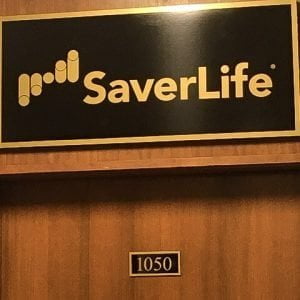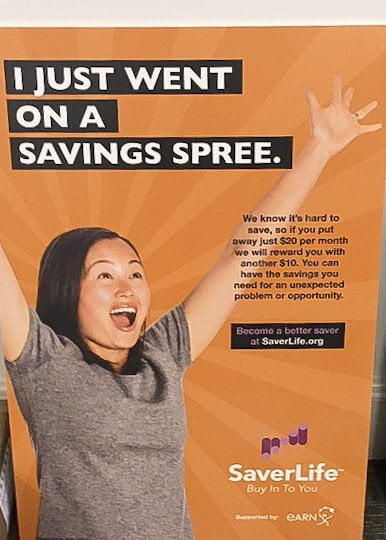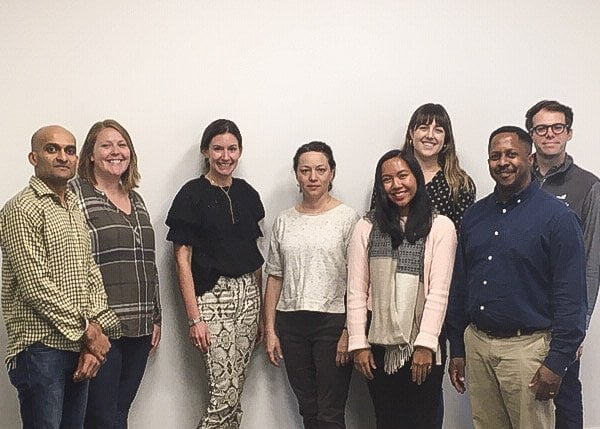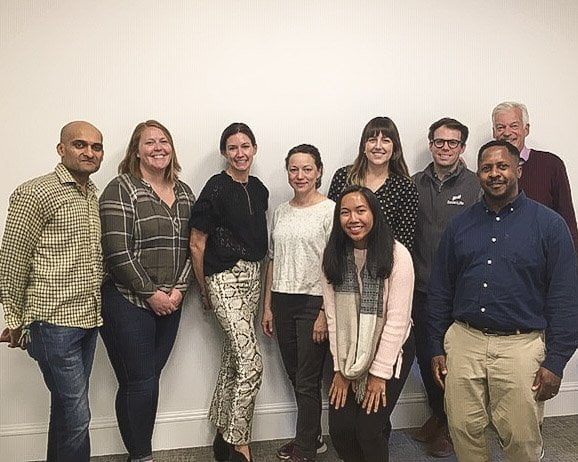Better Than Most is a regular feature of The Business of Giving, examining the best places to work among social good businesses and nonprofit organizations.
Denver: And this evening, we’re going to be going to Montgomery Street in San Francisco, and to the offices of SaverLife, a non-profit that helps people save money. We’ll begin with their CEO, Leigh Phillips, and then hear from some of the other members of the team.
Leigh: The organization has gone through a great deal of change in the last few years. We have been around since 2001 and I’ve been CEO here since 2015, and in that time, we’ve transitioned from a local direct service organization to a national technology-driven organization. And that’s been a big culture shift for the organization and what we do. But we made that decision because the problem that we’re trying to solve — the lack of savings and financial stability in the US — is a huge problem. And so, we felt that we needed to stand up a huge, a big solution that was scalable. But along with that has come a lot of change when you think about the culture. So, one of the things that I try and keep top of mind is: in a tech-driven environment, how do you stay close to your clients? How do you really keep the human face and not just tied behind or get behind the technology?
And so, we do a lot of, obviously, data collection, but we also do a lot of storytelling and lots of people on staff are frequently engaging with our clients and talking with them. And it’s oftentimes that we’re sharing those stories out at meetings or on Slack or in other ways or in published reports.
David: We actually have a pretty cool work-hard-play-hard kind of culture. So work hard in the sense that things are able to happen, move quickly, and really kind of give independence to people to be able to do things, but playing hard — being able to have fun while we’re doing it.
 Kush: I find that at SaverLife, here, I find that we have one culture. We have one team, one mission, one culture. I feel that we, as an organization, will have to work hard to keep that seed of culture intact because as teams grow, a number of people grow, departments grow, it becomes increasingly harder to keep silos from forming, from keeping walls and molds from developing. So, I think we’re at a great inflection point where we are still one culture, one village, one team, but we are quickly evolving. So, we’ll have to intentionally work hard to keep that spirit growing.
Kush: I find that at SaverLife, here, I find that we have one culture. We have one team, one mission, one culture. I feel that we, as an organization, will have to work hard to keep that seed of culture intact because as teams grow, a number of people grow, departments grow, it becomes increasingly harder to keep silos from forming, from keeping walls and molds from developing. So, I think we’re at a great inflection point where we are still one culture, one village, one team, but we are quickly evolving. So, we’ll have to intentionally work hard to keep that spirit growing.
David: We do a little bit of a card sort in advance. So either the hiring manager and people who will be on that team will go first and think about what are the different traits that we actually want in a person before they come on board. And then once a person has kind of gone through the various interview rounds, in the final rounds, they, too, have to make their own a card sort. We use that to see if there’s a match between how they see themselves in the organization and how we see ourselves and do they fit that part of the organization.
Leigh Phillips: So, people who work here with me probably know or will hopefully joke about the fact that I’ve never met a new idea I didn’t like. So, when it comes to what are the traits that we look for in team members and the types of folks we want to hire, we look for people with a lot of energy.
Tim: I don’t know that this is codified, but I’m pretty sure that there’s an unwritten requirement that to work here, you enjoy avocado toast.
Patty: So, I think that there’s really just this culture of pop by my desk, roll up a chair, let’s talk it out if you’re having a problem or you need help with something or we just want to get something done. I think It’s easy to make things more formal on email and that’s a good thing, but there also are just a lot of moments in life and at work that just popping by someone’s desk or sticking your head into their office is really the best thing to do.
I think there’s really this culture of open communication and camaraderie. People are laughing across their desks, and there’s always some time at the day when everyone is standing up and yelling across at each other, making silly jokes, whether that’s about someone [pulling] Black Friday deals for us on Slack channels. It’s a fun culture and an openness and ability to just communicate and not feel like you’re bothering someone when you stick your head in their office, which I do a lot.
Leigh: To build on something that Kush was saying, we do really try and take the best of what we’re learning from the corporate side or from the technology sector, and really apply it to social problems. That’s kind of what we’re doing here. And so, we are very much focused on not getting attached to our own way of doing things or getting attached to our solutions, but really looking at the experiences of our clients and trying to think about how we can help solve their problems as opposed to trying to think about what our solutions are and then enforce those on people.
 Shana: What’s the major reason people stay with the organization? I was just celebrated for eight years here on Thursday, and so I feel pretty comfortable answering that question. I think that SaverLife (formerly eARN) is a place where people innovate, where we bring ideas to a table, and those ideas, whether they’re good or bad, they’re listened to and they’re discussed. When you want to make a change, when you want something…you have an idea or you see a way to improve what we’re doing, you can bring it and we can actually make it happen that day or as soon as we want, whereas when you’re at a big company, it can take forever as you go up the food chain.
Shana: What’s the major reason people stay with the organization? I was just celebrated for eight years here on Thursday, and so I feel pretty comfortable answering that question. I think that SaverLife (formerly eARN) is a place where people innovate, where we bring ideas to a table, and those ideas, whether they’re good or bad, they’re listened to and they’re discussed. When you want to make a change, when you want something…you have an idea or you see a way to improve what we’re doing, you can bring it and we can actually make it happen that day or as soon as we want, whereas when you’re at a big company, it can take forever as you go up the food chain.
Tim: I think one of the things that you see how that manifests is this spirit of experimentation that we have. People can throw out ideas and there’s very little upfront, rejection of ideas. It’s really: If we don’t know, how can we get an answer? How can we use data to inform that decision? We’re willing to try all sorts of interesting and far out there ideas. Sometimes they don’t work and that’s fine, and sometimes they do, or you just continue to learn. That’s just something I really value within our organization is just has a spirit of trying new things and seeing what works.
David: So I would say the hard part is, the bar is: Can you measure it? Do you have some sort of data that you are going to either use to support why we should try it or some sort of a hypothesis that we need to find out why?
Danielle: I think that’s just super important to keep communication channels like that really open. I like to think of it as, “beyond water cooler talk,” and just knowing that the person who’s, who’s my manager, who’s like in charge of me, has my back and was always just willing to be open and being a good listener just really hit home. And it was really encouraging to hear that, especially on the first day.
Patty: We launched our new SaverLife rebrand, so we are SaverLife (formerly eARN), and that happened on my third week. So that was a little bit of a whirlwind. But I think that overall, the onboarding has been wonderful. I think I maybe was pushing myself to want to do, “I can figure this out. I can do this on my own,” and just really reinforcement from the team like, “We’re here to help. We’ve got you.” Really, everyone has been super helpful sharing things with me. “Oh, let me send you this. Let me send you that. Let me help you with this.”
Shana Beale: I wanted to talk about diversity, inclusion and equity. I can’t speak to all of them, but one of the things that I think…I do know that we seek to employ a diverse staff of people when we do hire. We look for diverse candidates who aren’t represented on staff or who could add a different perspective.
As far as inclusion goes, I feel particularly grateful to this organization because as a mom who’s had two kids while working at SaverLife, it’s hard to feel included when you can’t always participate in after work activities, and you can’t be a part of that same culture that you were before. But I do feel that SaverLife acknowledges what it’s like to be a parent, what it’s like to be a dog owner with a herniated disc, what it’s like to live far away, what it’s like to have all these different things, and that’s important.

The SaverLife dream team
Crystal: I’ll just quickly say in, in terms of personal and professional development, that’s one of our big values here, and there’s a lot of opportunity for that. Anytime that something comes up that seems like it may be a relevant opportunity for anyone on the team is marketed to the rest of the team. We each have a budget for professional development. It should be somewhat related to your job, but it’s also an opportunity to expand your skills and learn about other aspects of the work that we’re doing as well.
Kush: I will speak to the opportunities SaverLife provides to acquire new skills. We have this massive mandate in front of us to improve financial inclusion. There are many different tools, techniques, tricks, ideas that have yet been unexplored. So, all within us and people in my team have the authority to go and pursue new tools, methodologies, ideas, any of those across the board that they can employ to move the needle and get the job done. So, whether it’s a new technology platform and new skill such as SEO, some new technique with data analytics, some new tool that helps us gamify our savings platform… all of those are on the table. Everything goes.
Danielle: I was really interested in learning more about Saver interviews where we would interview some of our members in Savers, and then published an article on our website about that. I talked to my manager about it and she was really keen on me learning that as well to the point where I’ve actually taken that over. So, there is a lot of room to grow here at SaverLife.
Leigh: I also try and encourage everyone who works here to go and make friends with other people in other organizations and hear from them about the challenges that they’re facing or the things that they’re working on and to really reach out and collaborate. I think that that’s been really positive for our team members to know that we’re not the only organization that faces different types of challenges or to just go and learn how others are doing things.
Crystal: I would say one of my favorite customs of SaverLife is at the beginning of every team meeting – we have a weekly team meeting on Wednesdays – and it’s set in the agenda each meeting kicks off with appreciations. So, it’s a great way for us to publicly recognize and be recognized, our team members and show our appreciation and support of everyone on the team. And it’s set and we do it every Wednesday.
One of my roles prior to joining SaverLife, I worked at a technology company and was there from when it was in a startup phase and saw through an IPO. But something that I saw a lot there, even in the early days, that I haven’t seen working here, is that people would get burnt out. I think there are several reasons that that’s not something that I have seen here or experienced myself here.
One is that there’s that really clear tie to the mission and to the people that we serve, and that makes doing the work that we’re doing more meaningful. Another is that we’re allowed to be human. I’ve expressed human emotion here in the workplace and was just met with support and people asking me what I needed. I wasn’t made to feel embarrassed about that. Another is that as other people have mentioned, we do work hard and play hard. We work really hard during the workday, but there’s not the expectation that you’re working in the evenings or working over weekends or constantly meant to be connected. So I think that that makes a really big difference and allows us to be, frankly, more productive when we are working.

The SaverLife team with Denver Frederick
Denver: I’d like to thank all those who participated in this piece, Shana Beal, David Derryck, Crystal Sand, Danielle Bautista, Kush Khandelwal, Patty Moddelmog, Tim Lucas, and Leigh Phillips.
To hear this again, read the transcript, or see pictures of the participants and the offices of SaverLife, just come visit denver-frederick.com.
The Business of Giving can be heard every Sunday evening between 6:00 p.m. and 7:00 p.m. Eastern on AM 970 The Answer in New York and on iHeartRadio. You can follow us @bizofgive on Twitter, @bizofgive on Instagram and at http://www.facebook.com/BusinessOfGiving

